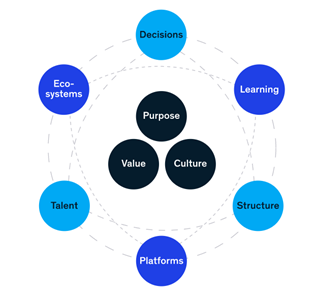Introduction
The COVID 19 pandemic has suddenly changed the expectations of the employees. Today it is required that employees should know how to deal with the technology and other digital tools. While organizations, leaders, and employees have been striving to settle in the new normal, the focus so far has been only on sustenance. However, to survive the present times and build capabilities to bounce back once the circumstances improve, what’s key is the experience.
Implementing a remote working was the only way out to keep operations running despite the lockdown, however, it is yet to see whether organizations are fully prepared to leverage flexible work as a strategic approach to mitigating risk.It seems that the entire world is in the Big Reset mode. The crises of COVID 19 are disruptive and devastating and all the big and small companies are rapidly changing and the effects will be long-lasting for several years to come. “No one ever thought that a function like HR that deals with human interaction, might need to move to virtual mode – including employee interaction, training sessions, exit interviews, and even first-day induction”, shared Sushant Patnaik, Head-HR, Aeris Communication.
But there is no going back. Organizations and the leaders along with the employees are striving to set in the new normal. The emphasis is on sustenance. However to bounce back once the conditions improve much lies on capability building, adaptability, and agility of the organizations. Sr. Vice President of IBM said that today 90% of IBM’s workforce is remote and contributing to the company. And so Eric from the NBA said that “remote work” is now becoming new normal.
Around the globe organizations are witnessing disruption in the workforce at an unprecedented scale and pace. Organizations are consenting that pace is the essence and the employees and the leaders are striving to function and perform while coping up with what they are undergoing in their daily lives.
Issues of HR
The responsibilities of HR have shifted into four important areas:
- Physical health and wellbeing
- Remote working
- Jobs and work continuity
- Urgent need for mental health, resilience, family support, and dealing with uncertainty.
Chief Human Resource Officers across the globe are trying to cope up with these challenges by helping organizations and people by navigating the workings of the remote workforce, protecting and empowering their employees, trying to serve their customers, and establish business continuity. They are trying to become more techno-savvy and digitalized so that the work goes on and can retain their people. The HR Leaders are developing agile workforce strategies to keep a sustainable economy and helping people and their families survive financially now and in the future. Opportunities are emerging as companies and industries work together to keep people in paying work. We can take the example of Accenture which has aligned with CHROs of prominent leading companies and has created People + Work Connect, a platform to facilitate continuous employee engagements.
The CHROs have started playing the pertinent role in making themselves enabled to work with advanced technologies so that they can navigate these uncertain massive shifts in the workforce.
What HR are Doing
- Shifted from office working to remote working
CHRO of IBM Diane Gherson said that 95% of the taskforce have become remote and even Eric of NBA confirmed the same. Now the remote work condition is becoming new normal. There has been a drastic and sudden increase in the usage of Zoom, Webex, Microsoft teams which made the concept of work from home stronger.
- Health and personal safety and hygiene
Today people, health, and safety have become top issues for the company The companies are understanding and taking this at priority. Social distancing, no more handshakes, sanitization self, and office places have become mandatory.
- Digitalization for sustenance
Companies are going digital transformation which is now vital. They are adapting to new technologies, tools, behavior, and culture which has been suddenly accelerated. HR Leaders and organizations are trying to become far more connected now than before the crises.
- Sensitivity towards employees.
HR Leaders and organizations are trying to become far more connected now than before the crises. Being more empathetic, caring, and sensitive is what is required now.
- Empowering people
The military strategy “distributed authority with central coordination” that is taught during war is needed now. Every function of HR should coil up with the strategy of empowering people with central control based on values.
- Do more with less
Industry leaders are traveling the rough road in this crisis as a people leader. There is a famous saying that; worst of times brings out the best in people and is true with the organizations as well. Today almost all the organizations all over the world being challenged by COVID 19, are trying to find innovative ways to sustain themselves while serving their customers.
7.Move Fast And Win Together
There is a famous saying “slow and steady wins the race,” but the concept is changing now as those who are changing and adopting fast may win the race. The HR leaders and CHROs are focusing on priority teams to keep the business ongoing.
- Real-Time Data means a lot
As mentioned by Rich, UHG, having more than 300,000 employees, did a massive change and relocated resources to ensure that remote working can become possible.
9.Continuity Planning Is Vital: Black Swan Events Happen All The Time
Continuous planning, being proactive is something that is not used once in a decade, but need to plan for “ things going wrong” as everyday operations. Every company will have a “Black Swan” event periodically for example The PG&E fires in California, Wells Fargo sales commission problem, Boeing 737.
10.Leadership Matters
HR Leaders and CHROs are inspired by the challenges and today particularly in the global crises they are Heroes of the companies. They are not only worried only about the economy of the company but are more concerned about health and personal safety, executive and workplace safety, ethical policies of the company.
These responses of HR are heroic efforts. Amid the fear and uncertainty one of the most important organizational capabilities is organizational agility. The inertia needs to be ended. The organizations must work fast on crisis response teams, fast distribution of authority, implement real-time data collection, being empathetic, and transparent and fast communication. Across the globe companies are struggling to fast adopt the abstract challenges in the form of digital technology, artificial intelligence, automation and machine learning. Post Pandemic organization will take shape along three dimensions:
- Who we are
- How we operate
- How we grow

Source: McKinsey
The way pandemic paced up, it brought all the leaderson to their toes and the surprise of how fast employees changed, adopted and started performing at new levels.The speed of the pandemic surprised everyone. So, too, did the fast reflexes of some companies: even their leaders were shocked at how quickly colleagues stepped up, made dramatic changes, and began performing at new levels. Fear for corporate survival surely played a part, but our conversations with global leaders suggest that stronger motivations were a clear sense of corporate identity and a desire to simply be there for customers and one another. More love than fear, in other words. How do you know if you’re in such an organization? Simply put, you know who you are and what you stand for as a company; this becomes a “North Star” that guides people in times of chaos and uncertainty. You know why and how your company is different from any other: why it exists, how it creates value, and “how we run the place.”
It is not that the all-hands-on-deck ethos of a pandemic won’t last; it is what is required now, but need to but there are ways to understand what needs to be done which can be beneficial and substantial. We can look back to the 2008 global economic crises, companies that were performing and were in the top five were 20 percent higher than their competitors and only after eight years they were higher by 150%. What we learn by this is that the companies that move earlier, faster, and strategically perform well. It is not only the survival of the fittest but also survival of fastest and quickest. Companies require flexibility, collaboration, inclusiveness, and accountability to succeed. The colossal changes of organizations concerning pandemics should foster these values.
Conclusion
CHROs and the Business Leaders have understood how and what can be done remotely. They have institutionalized pace and scale of innovation at the workplace businesses are forced to do more with less, many are finding better, simpler, less expensive, and faster ways to operate. Hence now people of the company will have more expectations from their HR leaders. The organization now needs to be based upon building strong bonds, appreciating diversity as the pandemic times have allowed receiving new windows on everyone’s life and hence can provide a better foundation to work in the future.
References
[1] Susan Caminiti, “How the coronavirus crisis has elevated the role of HR chiefs in the C-suite”
CNBC.Com Published, Apr 22 2020
[2] Nurhuda Syed, “Coronavirus: HR’s role in business continuity plans”, Human resource director, Feb 25 2020
[3]Bratindra Sanyal, “The Evolving Role of HR During COVID Crisis”, BW People.in, April 28 2020
[4] Jeanne Meister, “The Impact Of The Coronavirus On HR And The New Normal Of Work”,Forbes, Mar 31, 2020
Disclaimer: The views expressed are of the author(s) and do not reflect the official policy or position of Diplomacy and Beyond Plus. The publication is not liable for the views expressed by authors.









